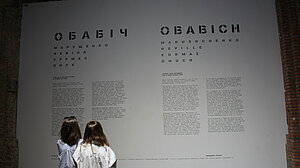"If you have a wall, you have a consciousness about the neighbour"
Interview with Jerzy Onuch, curator of 'Obabich'

What does Obabich mean? Where does the word come from and why did you choose this title?
Jerzy Onuch: Well, it was quite a long process. Knowing the theme of the Book Arsenal, which is Neighbours, I wanted to create a certain type of tension to and extension of this theme. I decided to build this huge wall and finally the two walls and the tunnel. In my understanding of the relationship between neighbours, if you have a wall you have a consciousness about the neighbour. If there is no wall, the question of neighbourhood kind of disappears. When I created this wall, it was not just a border, but there was was obviously the question that there are both sides of it.
So at the very beginning, I developed the title “On both sides of the wall” (a physical, or imaginary wall, it doesn’t matter). When I discussed it with a colleague of mine who’s a writer, she came up with a very beautiful sounding word that is not often used in Ukrainian, a very literary one: Obabich. In other languages, for example in English and Polish, you have say “On both sides” – three words to describe the feeling that the word Obabich conveys.
You talked about a wall, but you created a special construction to bring the two artists, the works of Mark Neville and Viktor Marushchenko together. How did you develop the idea of the tunnel?
I started with the idea of a wall. I thought that perhaps on one side of the wall there will be the works of Marushchenko and Neville’s works on the other side, but that didn’t work for me. So I said ‘Okay, I will build two walls then, so that every one of them has their own wall, their own universe’. When I imagined those two walls it was just a simple decision to put a roof on them and this automatically created a tunnel. The construction developed organically, and finally we came to what we have. All of the solutions are rooted in their meanings.
In the exhibition, people enter with headlamps and look at Marushchenko’s works in the complete dark, just as if they were miners themselves.
Yes, exactly, so they can relate to them. They are inside a tunnel with headlights and look at the pictures of miners wearing headlights. For just a second or half a second they can connect with them. Not only by what they are seeing, but through a physical connectivity: One day, I could have been or I could be in such a space, in such a situation. It was an obvious decision to put Mark Neville’s works outside of the tunnel, in two different series: one series of internally displaced persons, on the other side images depicting beach life in Odessa that seem to be saying: Life goes on. People want to live, people want to enjoy the way they know, the way they like, even if it’s quite a kitschy way of doing it, but this is what it is.
Why did you decide to include a graffiti by the Ukrainian artist Sasha Kurmaz?
It was too clean for me, this perfect, grey tunnel. In the centre of the city in Kyiv graffiti’s everywhere. So I said, ‘We have to use it in some way and give the message that this is how Ukrainian cities look like’. It’s a way of telling stories on the walls, on the terraces. I started to think about an artist and found Sasha Kurmaz who is doing many different things today, but years ago, he started exactly as a graffiti artist.
In your opinion, what is the strongest relation between Marushchenko's ‘Dreamland Donbas’ from 2005 and the more recent works by Mark Neville?
I think there is not one but many relations or better still: a kontrapunkt. First of all, every story has its own history. When Neville takes pictures of displaced persons, we have to ask: Why are they displaced? When did it happen? When was the beginning of this problem? And I've got a perfect example with the works of Marushchenko. When we presented them 15 years ago, the project wasn't accepted by the political or intellectual audiences in Ukraine, only just by art critics. It’s a certain key: We have one story and now we have another story. Both stories are connected to the region but in a different historical dimension and they relate directly or indirectly.
I believe the exhibition has many levels. It can generate many different feelings and people can read it in many different ways. I thought about it in terms of making a certain impact: You’re coming into this huge, beautiful space and you are just struck by the lights and then by the darkness, by the tunnel, all those very definite acts and signs. You have to be kind of struck from the very beginning: ‘Wow!’ and then ‘Well?’ – and by going into this tunnel you are going deeper and deeper into the story.